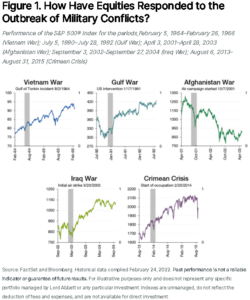
John M. Duncan 2021 Award Winner – Lois Novakovich
February 17, 2022
Snowball or Avalanche? Choosing the Best Debt Repayment Strategy
March 7, 2022The Russian invasion of Ukraine on February 23rd came with corresponding market reactions, with both equity and fixed income displaying volatility while commodity prices climbed, notably oil and gas. It is a fluid situation but arguably still calls for time tested strategies of being opportunistic with attractive buying opportunities and staying committed to a long-term disciplined approach. With markets in or hovering near correction territory and a roller coaster week behind us, we assess the current conditions and implications for what’s next.
Among other trends, the themes investors are watching closely as the broader fallout is assessed:
- Higher energy prices
- Possible reduced access to raw materials
- Higher food prices
- Impact of sanctions
The energy implications are more substantial for Europe than the United States, as we are a net energy exporter. As more efforts are put forth to divert supplies to Europe, supply constraints and the willingness of the Middle East to ramp up production of oil and gas will play a large role in prices and corresponding effects felt by consumers. There are many moving parts to this equation, Brent and WTI at $100 levels will create a rising cost environment that if left unchecked, will leave the consumer with less to spend on other goods and services.
Ukraine is a major food exporter and agricultural prices were already rising significantly over the past several months. Wheat and grain prices have increased sharply since the conflict began. However, Brazil, Argentina, Australia, Canada and the U.S. are also major grain producers and it seems likely that domestic planting will hit records this Spring. Other food growers will likely replace whatever production is lost from Ukraine, possibly fairly quickly. Other beneficiaries include domestic fertilizer companies and agricultural equipment manufacturers.
The Black Sea and the Sea of Azov are home to ports where grain, chemicals, steel and other exports are loaded and shipped to other parts of the world. In the early days of the war, three non-military cargo ships were damaged by Russian air strikes or missiles. As a result, the London marine insurance market changed the risk status of the Russian and Ukrainian waters in the Black Sea and the Sea of Azov, designating them as high-risk regions. The change will increase the costs of shipping and could push global inflation higher.
Regarding sanctions, a number of high profile companies are either curtailing their operations in Russia or leaving entirely. BP PLC announced on Sunday its plans to exit a 20% stake of Russian oil producer Rosneft. As these changes take effect and supply chains are further tested with changes and redirection, it adds to the already significant logistics challenges that exist. Investors will continue to digest the implications and we see inflationary and supply factors associated being a negative for the short-term global economic outlook.
Considering all of the risks aforementioned, what’s next? Short-term downside risk remains given the uncertain scope and timing of the conflict, even while Ukraine and Russia negotiate a resolution. In either case, one can argue that profits achieved by U.S. companies may still continue to grow in 2022, setting up for more likely moves to the upside as we move throughout the rest of the year.
What’s more, the market has correctly concluded that the risk of a 50 basis point hike at the March FOMC meeting is highly unlikely, but this was considered unlikely even before the invasion of Ukraine. Looking further out, the Fed is likely to “continually reassess”, but the Fed will want or need to normalize rates to contain inflation.
Thus far, this development has been seen as a positive to growth stocks which rebounded late last week, and have been hard by rising interest rates the prospect for additional hikes. We also continue to favor the dividend equity story and companies that have the ability to grow their distributions in the inflationary environment we will continue to navigate. All else equal, we feel the case for the long-term buying opportunity is in play, especially in these two categories. Looking at history, the beginning periods of conflict can be an attractive entry point:

The world will continue to watch as the story unfolds and the countless cascading effects for the companies and consumers are realized. With our eye on the trends that matter the most for your portfolio, we’ll remain disciplined and opportunistic in achieving your financial goals.




